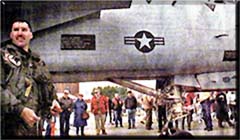submitted by the
Empire State Aeroscience Museum via Torsten Anft
as published in the Daily Gazette, Wednesday,
November 26 1997
Tomcat zooms into
resting place
Aerosciences
Museum receives Grumman F-14 A under full power
By LYNN
BREZOSKY
Gazette Reporter

Photos
by BRUCE SQUIERS,
Gazette Photographer
IIts
variable-wing geometry swept back for speed, a
Navy F-14A Tomcat passes low over the Schenectady
County Airport Tuesday just before landing at its
new permanent home at the Empire State
Aerosciences Museum. Pilot, Lt. Cmdr Tom Mills,
gives the plane a final inspection before turning
it over to the museum. About 40 spectators came
out to see the jet land.
GLENVILLE
- After 20 years and some 5,000 hours of flight
time a Grumman F-14A Tomcat zoomed gracefully to
rest in its state of birth Tuesday. The Tomcat is
probably best known as the high-tech wonder flown
by Tom Cruise in the 1986 movie "Top
Gun". In real life, the fighter planes have
maneuvered over such hostile places as Bosnia,
Somalia and Iraq. In the Persian Gulf War, the
sleek two-seaters downed Iraqi aircraft. After a
fresh coat of steel gray paint, the plane now
joins 50 years of vintage, made-in-New-York
aircraft showcased at the Empire State
Aeroscience Museum on Route 50. Designed and
built in 1972 by Grumman on Long Island,
the model also has the proud distinction of being
the first plane to actually fly into the museum's
airfield. After a 380-mile, 43 minute flight from
Oceana, Virginia, this
plane didn't just fly to its final landing. It
turned, sliced and arched in low circles over
some 40 spectators gathered by the runway gate.
Other aircraft parked there were toted, lifted
and dragged -sometimes piecemeal - then lovingly
restored by the crew of about 150 plane buffs
volunteering at the museum. Also unlike the other
planes at th museum, which have their engines
removed, the Tomcat's engines will remain intact.
Hopping out of the plane and stripping off their
outer flight gear, Lt. Cmdr. Tommy Mills, the
pilot, and Lt. John McFadden, the radio intercept
operator, seemed undaunted by their frigid
northern landing. Noting the enthusiastic crowd
gathered around with questions - and
recollections from their own cockpit days -
McFadden said "this is certainly better than
sendin it to a boneyard". Among those at the
Air Museum Tuesday was 82-year-old Col. Augustus
Russell Agneta, who flew B-17s during World War
II and helped design the F-14 at Grumman in 1970.
Agneta and his wife sponsored the plane's arrival
at the museum. Then, Agneta said, the aircraft
cost $10 million to build; now they cost about
$30 million. The F-14's capabilities include
acceleration of 0-to-150mph in 3 seconds,
altitudes of 50,000 feet in 10 to 12 minutes, and
a range of 2,000 miles without refuelling. Agneta
said "It still does what it was designed to
do better than any other aircraft in the
world".
related
items on this site:
Newsletter story, VF-14
Aircraft History, F-14,
VF-14 Roster
|